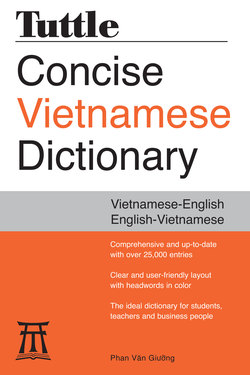Читать книгу Tuttle Concise Vietnamese Dictionary - Phan Van Giuong - Страница 7
ОглавлениеHow To Use This Dictionary
This dictionary is in two parts: a Vietnamese-English section and an English-Vietnamese section. The entries in each section are arranged alphabetically, following the English order from A to Z; and according to the Vietnamese tradition for tones and sequence for the Vietnamese-English section.
The components of each headword are as follows:
1. Headwords are printed in color, followed by the word class (given in italics). If the headword has more than one word class, the different classes are numbered:
eùm v. to cover up, to hide
land 1 n. ñaát lieàn, luïc ñòa; ñaát, ñaát ñai (ñeå troàng troït); vuøng, xöù sôû, ñòa phöông, laõnh thoå; ruoäng ñaát, ñieàn saûn 2 v. ñoå boä; ñöa ñeán, ñaåy vaøo; ñöôïc, baét ñöôïc; giaùng (ñoøn); (maùy bay) haï caùnh; caäp beán
2. Square brackets are used to give more information for each entry: such as cross-references to other headwords, the past tense and past participle of the English headword, etc:
phuï hoaï v. to echo, to repeat [someone’s opinion]
bear 1 n. con gaáu: ~ hug oâm chaët 2 v. [bore; born/borne] mang, caàm, vaùc v.v. chòu ñöïng, sinh (saûn), sinh lôïi; to ~ interest sinh laõi
3. Meanings of Vietnamese headwords are in low cases. If the headword has different expressions in Vietnamese, they are separated by a comma (,) and if they have different meanings, they are separated by a semi-colon (;):
oaùn v., n. to resent, to bear a grudge against; resentment, hatred: thuø oaùn to resent; aân oaùn ingratitude and rancor
4. Extended vocabulary items and sample sentences using the English headword are first given in English, followed by the Vietnamese translation. In order to avoid repetition of the headword in these extended vocabulary items or sample sentences, the symbol ~ is used to represent the English headword:
pace 1 n. böôùc ñi; daùng/caùch ñi; toác ñoä, nhòp ñoä: to keep ~ with theo/saùnh kòp; to set the ~ neâu göông; to go at a walking ~ ñi töøng böôùc; to go the ~ ñi nhanh; aên chôi phoùng ñaõng; to put someone through his/her ~s thöû taøi ai, thöû söùc ai; cho ai thi thoá taøi naêng 2 v. ñi töøng böôùc, böôùc töøng böôùc: to ~ up and down the corridors ñi ñi laïi laïi doïc theo haønh lang
For the Vietnamese-English section, the extended vocabulary items are separated by semi-colons:
ra 1 v. [SV xuaát] to exit, to go out, to come out; to go [out] into, to come [out] into; to look, to become; to issue [order leänh], to give [signal hieäu, assignment baøi]: ra beå to go to the sea 2 adv. out, outside, forth: khoâng ra gì, chaúng ra gì to amount to nothing; baøy ra to display, to show off; ñoû ra to become red; noùi ra to speak up; nhôù ra to remember, to call forth; tìm ra, kieám ra to find out; cöûa ra vaøo door; hieän ra to appear; hoaù ra to become; it turns out that; thaønh ra to come out; chia ra to divide up, to divide into
5. There is a variety of terms used to address the first and second persons in Vietnamese. As shown by the following example:
baø 1 n. [SV toå maãu] grandmother; female: baøngoaïi maternal grandmother; baønoäi paternal grandmother; ñaøn baø woman, women 2 pron. lady/you [used by grandchild to grandmother, first person pronoun being chaùu]; I [used by grandmother to grandchild, second person pronoun being chaùu]; you [used to refer to women of a certain age, first person pronoun being toâi]
toâi is used for the first person and chaùu for the second person. The reader can replace these terms with oâng, baø, anh, chò, em, tau, maøy... depending on the age and relationship between the first and second persons.
6. Vietnamese words that are loanwords have their Vietnamese pronunciation connected by hyphens (-), for example:
centimeter n. xen-ti-met, phaân
ki-loâ n. [Fr. kilogram] kilogram
7. List of abbreviations used in this Dictionary are as follows:
